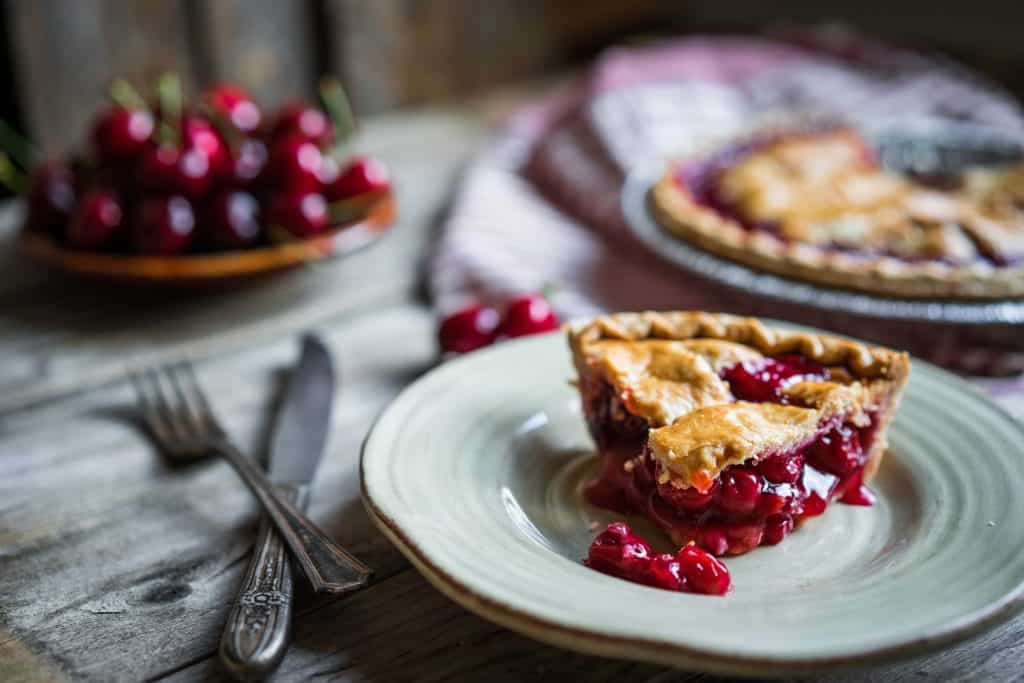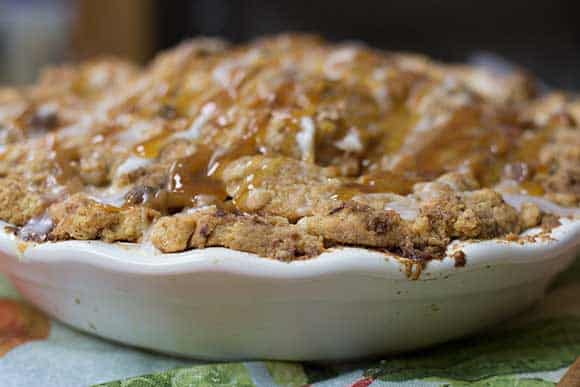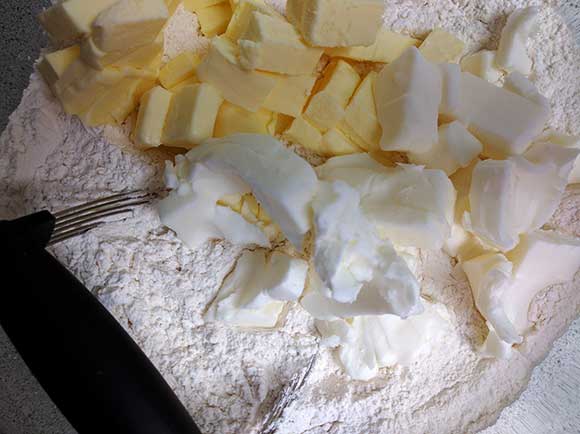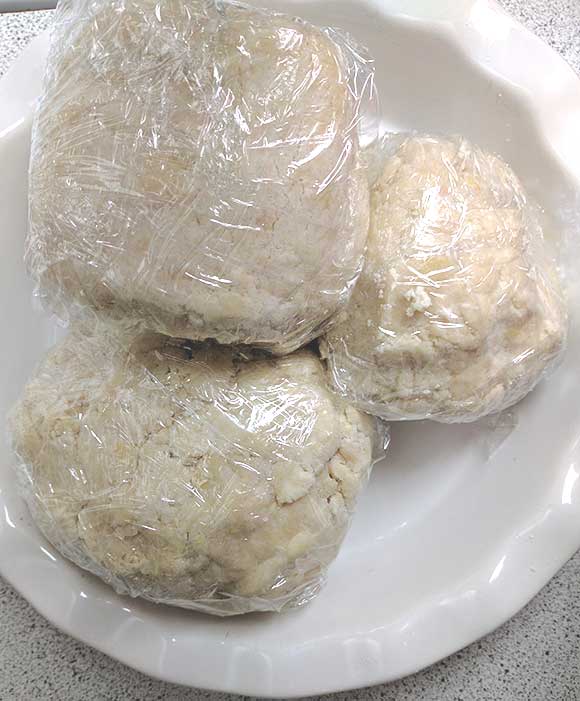What is the Secret to Perfect Flaky Pie Crust?
You may be wondering:
What is the secret to Perfect Flaky Pie Crust?
Melt in your mouth, homemade pie crust with buttery flavor.
Perfect Flaky Pie crust that’s golden in color and slightly crispy on the edges.
Most important of all?
No Soggy Bottoms.
I’ve been making homemade perfect flaky pie crust and baking perfect pies for over 40 years. I’ve tried many different recipes and there are some really good ones out there. Have you tried the one that uses vodka? 🙂
But this post is all about
perfect flaky pie crust
And do you know what?
The # 1 question I get asked by readers is “What is the secret to perfect flaky pie crust?” , so it’s not just you!
We’re going to spend some time together. And don’t worry if you don’t have that time right now.
You can pin this post to your favorite board for later!
And I have this amazing e-book How To Make Perfect Flaky Pie Crust to share with you, like a step-by-step guide so that you will always have it right when you need it!
So we’re going to go into some detail about two important areas to help you get ready to make perfect flaky pie crust. It’s all about having great tools, right? So we need to start with Baking Equipment and Baking Ingredients. I want to take you through the basics of both. That way when you decide you want to make up a batch of homemade pie crust, you will be ready to go!
#1 Pie Baking Equipment
Please note that I only recommend products that I use and love. I’ve chosen these with care, and all are from Amazon, either Amazon Best Seller, Amazon Prime or Amazon Choice! * This post may contain affiliate links – what does that mean?
Before we start baking together let’s review the different types of baking equipment I will be using.
1. Measuring cups and spoons – You can never have too many of these! Try to have both clear and plastic measuring cups and a variety of spoons – it’s helpful if the measurements are shown in both metric and imperial.
2. Mixing bowls – stainless steel, glass, ceramic or plastic, in several different sizes. Small ones to measure ingredients into and also very large ones. When we mix the pastry dough by hand, you need a very large mixing bowl – I use it for a variety of things. Try to get one that is at least 4 quart/4.4 liters.
3. Pastry Blender and Pastry cutter – The hand held pastry blenders are easy to find in any kitchen section. I like the ones with the smooth tines – not the razor sharp ones, I think they are safer and easier to handle. A pastry cutter is really handy to trim the pie crust when you are ready to put it in your pie plate, or for making lattice and decorative crusts!
4. Pastry Mat – I’ve only just started to use pastry mat, and let me tell you, it’s a real time saver! There are so many choices, and the ones I prefer have the different sizes of pies stamped on them. As long as it’s plastic and easy for you to clean, you should be fine. And if you see one for under $25, then grab it.
[box] Please don’t be overwhelmed by the equipment list. These are the basics and you will use them for life! [/box]
5. Pie Plates – My Go To pie plate is a 9.5”/24.1 cm deep dish pie plate – for both the apple pie and chicken pot pie. It’s made of Pyrex so safe for the oven. It’s also a good idea to have aluminum foil pie plates on hand. They are easy to pop into the oven, or use when you are baking for sale, or potluck! These come in 8”/20.3cm size
6. Rolling Pins – I will be using a traditional french rolling pin, with a medium weight, and the size is 18” long, doesn’t stick and will be perfect for any type of dough you need to roll out. I prefer this type of rolling pin for new bakers, it’s easy on the wrists, and as you gain more experience, you will want to branch out to silicone, stainless steel, or even marble!
7. Oven mitts – for safety’s sake, please use heat retardant oven mitts to protect yourself. There are many varieties on the market, and these ones get great reviews!
8. Apron – a chef’s bib apron is the best choice, that will protect your front, and having a pocket is always nice. Fabric should be easy care and that means no ironing! You will feel very professional learning to bake in this apron.
9. Cooling racks and pads – Once your pie is baked and you take it out of the oven, a cooling rack or heat pad is needed to protect the countertops in your kitchen. Pies cool best away from the heat of the oven. Cooling racks and pads come in all shapes and sizes. Get one that is at least 12” X 7” / 30.5cm X 17.5cm.
#2 Get to Know Your Oven
Once your perfect pie crust is made and you are ready to build your pie, it’s time to pre-heat the oven. Check your recipe to see the correct temperature. If your oven doesn’t have a timer, use a small kitchen timer instead, or set the time on your smart phone.
Baking times are usually provided in a range – for example 30 to 40 minutes. That’s because all ovens heat differently due to a number of factors, gas or electric, and including the altitude of where you live! So my approach is to choose the lesser time- in this case 30 minutes and then add time if I need to. As you become more experienced, you will get to know your oven temperatures and times. And for those of you who are experienced bakers, this is what we call the difference between a ‘fast’ and a ‘slow’ oven.
#3 Perfect Flaky Pie Crust Baking Ingredients
Use the best and freshest ingredients that you can. Making perfect pie crust and pies requires some effort and we want the flakiest pie crust we can bake. So let’s talk about flour and fats – the main two ingredients when making pastry dough, and where short crust pastry originated from.
Flour: All Purpose, Cake & Pastry, and Gluten Free Flours
What is the best brand and type of flour to use for making homemade pie crust? There are a few different types of flour to choose from when it comes to making pastry dough. These include All Purpose Flour, Cake and Pastry Flour and Gluten Free Flours.
Cake and Pastry Flour – is made from softer wheat varieties and has very low protein content – about 8%. So this is what I often use when making pie crust.
Note: If all you can buy is All Purpose follow you can add 2 tablespoons of cornstarch to a level cup of all-purpose flour and this will be a good substitute.
Gluten Free Flour – These are relatively new to the mainstream markets, and you can now find blended gluten free flour in your local food store. There are a number of brands out there, and gluten free pastry is discussed in our Facebook group, The Perfect Pies Club. Gluten Free blends do not have wheat gluten in them, so they include starches such as potato starch, tapioca, sometimes buckwheat.
Fats: Butter, Lard or Vegetable Shortening – what should I use to get perfect flaky pie crust?
The difference between vegetable shortening and lard is that the higher fat content in lard produces flakier pastry, however vegetable shortening tastes more like butter. I’ve used both and really can’t tell the difference. Feel free to experiment with one or the other. The methods for mixing will be the same.
For our recipe below we are using unsalted butter and vegetable shortening (half and half). This pie crust is delicious for both sweet and savory pies and due the animal fat content in butter (from dairy) the piecrust is quite flaky. Again it is all personal preference. I have tried all of them and switch back and forth between butter and vegetable shortening.
When you mix gluten free pastry dough, use vegetable shortening since it doesn’t produce gluten protein.
Shortcrust Pastry is the professional term used for pastry dough that is used to make pies and tarts. It actually originated with the Romans, when they would mix flour and water together to make a paste and wrap it around meat and bake it.
In this perfect flaky pie crust recipe, we will be using half butter and half vegetable shortening.
#4 Getting Ready to Make Perfect Flaky Pie Crust
Getting Ready to Bake – It Helps to Stay Organized
When I’m baking I like to measure out all of my ingredients ahead of time and also have all of the baking equipment I will need out and easy to get to. Once we start to mix the pastry dough you don’t want to have to stop and wash your hands to get something out of a drawer or cupboard. And getting ready this way does save time. These tips will really help to make your baking experience enjoyable!
- Have you got a clean counter on which to work? Putting away the clutter will help you to focus on your pie crust.
- Print out your recipe and get out all of the ingredients.
- Make sure you are not being distracted when measuring as measurements must be precise.
- Make sure you have your apron on and oven mitts at the ready.
- It’s also helpful to clear space in your refrigerator. You will need to chill the pastry dough and that requires space in your refrigerator – not a lot, but enough to hold your mixing bowl.
- Before you roll out your pastry dough, get out your pastry mat.
- Get the pie plate ready – by greasing it.
- Once you have the pastry made and in the pie shell, chill it for 30 minutes before using it in your pie recipe.
- And bake with a clean oven. Splatters and baked on food could set off the smoke alarm! I usually line the bottom of my oven with a sheet of aluminum foil to catch any spills.
- Let’s have some fun!
When my students ask me “What is the secret to flaky pie crust?” My answer is always the same. It’s the blending of the flour and fats, the layering of the pastry, that will give you that buttery flakiness.
#5 Pie Crust Tips & Tricks:
- If you have left your pastry in the refrigerator for longer than thirty minutes – just let it sit until it becomes room temperature, before you start to roll it out.
- Pastry freezes really well, and you can keep pastry frozen for up to a month. Again just take it out and let it thaw – don’t try to heat it up in the microwave.
- Fluting the edge of your piecrust takes a little time and patience – don’t worry about perfection as every pie baked is unique!
- Brushing a wash of egg yolk on the top of your pie crust will result in a lovely golden crust, especially with a two crust pie.
- Sprinkle some granulated white sugar on the crust just as you take it out of the oven. It will stick and add some sugary sweetness.
- Presentation is just as important as taste! Serve your beautiful pie with Whipped cream, ice cream or caramel sauce. Your family and friends will love you for it!
The steps to blending the flours and fats are here for you to follow.
Getting the consistency of your flaky pie crust right is really important, so I’ve included a video on how to roll out your pie crust.
It’s kind of like the Three Little Bears:
Too thick and your pie crust will be tough.
Too thin and it won’t hold the filling.
It has to be just right!
And you know the best part?
We’re going to make pie crust together in the video below!
#6 Judy’s No Fail Perfect Flaky Pie Crust:

- 6 cups flour
- 1 tsp baking powder
- 1 tsp salt
- 1 cup cold unsalted butter, cut into small chunks
- 1 cup cold vegetable shortening, cut into small chunks
- 1 egg
- 1 tablespoon white vinegar
- Ice Cold Water

Mix the flour, salt and baking powder in a large bowl.
Add the fats, and using a hand pastry blender, mix the flours and fats together.
Whisk the egg in a cup, add the vinegar and enough water to fill the cup.
Pour onto the flour mixture and blend well. I use my fingers, but use a very light touch.
You don’t want to over blend or work the dough too much. Otherwise the pie crust will be tough.
Shape the pastry dough into 4 evenly shaped balls, wrap them in plastic wrap and place in the refrigerator for at least 30 minutes.
#7 Rolling out the Dough – video
Now comes the fun part! I really believe that this is the most important part too, where we either end up with flaky pie crust, or a crust that becomes very tough. You’ve seen those pies where people scrape out the filling and leave the crust? That’s so not going to happen here!
Using a pastry mat, roll out your pie crust as shown in the video. Be sure to remember to chill the crust for 30 minutes before filling and baking. Remember we talked about the importance of keeping the dough chilled? Pie dough likes it cool!

Judy's No Fail Perfect Flaky Pie Crust
Pin RecipeClick to Rate!
Ingredients
- 6 cups flour
- 1 tsp baking powder
- 1 tsp salt
- 1 cup butter - unsalted, cold, cut into small chunks
- 1 cup vegetable shortening - cold, cut into small chunks
- 1 egg
- 1 tablespoon white vinegar
- 1 cup Water - ice cold, enough to fill the cup with the egg and vinegar in it
Instructions
- Mix the flour, salt and baking powder in a large bowl. Add the fats, and using a hand pastry blender, mix the flours and fats together. Whisk the egg in a cup, add the vinegar and enough water to fill the cup. Pour onto the flour mixture and blend well. I use my fingers, but use a very light touch. You don't want to over blend or work the dough too much. Otherwise the pie crust will be tough.

- Shape the pastry dough into 4 evenly shaped balls, wrap them in plastic wrap and place in the refrigerator for at least 30 minutes.

- Using a pastry mat, roll out the dough evenly and until it is the right size to fit your plate.

- Wrap the dough around the rolling pin and rest the pin and pastry dough in the middle of the pie plate, in order to centre the pie crust.
- Unroll the pie crust, gently pushing it into a well greased pie plate,
- Crimp the edges using your knuckles of the index and middle finger on your right hand, and pushing with your third finger on your left. Or vice verse if you are left handed.

- Prick the bottom crust a few times with a fork.
- Wrap the pie crust in plastic wrap and chill for 30 minutes before baking,
VIDEO

These are estimated values generated from a nutritional database using unbranded products. Please do your own research with the products you're using if you have a serious health issue or are following a specific diet.
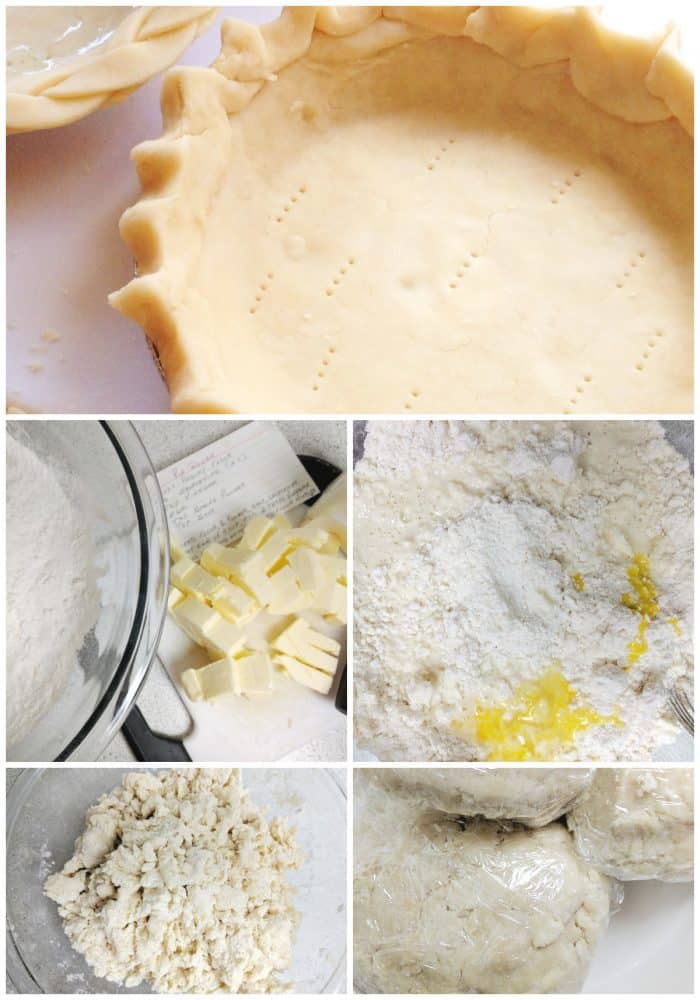
So to answer the question “What is the secret to perfect flaky pie crust?” There really isn’t a secret. Just taking the recipe step by step, taking your time, using quality ingredients – all will add up to a perfect flaky pie crust.
Every time.
In addition to this post and our video, I’ve written a short ebook, How to Make Perfect Flaky Pie Crust, that you can access at the end of this post!

Related: Pie Crust from your food processor
I hope you really enjoyed this post,
there is lots of great information here!
Please feel free to share it on Pinterest right now!
Have some more pie!
Easy Apple Pie Recipe
Mom's Apple Pie is just the best, right? So we put together this very easy apple pie recipe, that is perfect for beginner bakers. If you have every wondered "how do I make an apple pie?" then this is the recipe for you!
Sweet Italian Easter Pie
This easy ricotta pie recipe has delicious chocolate and orange flavours. Easy to make it's so elegant when baked as a tart! The recipe makes two pies to feed a crowd!
Strawberry Pie Recipe
Strawberry Pie is the perfect pie for Spring! An easy recipe, and look at those beautiful pie crust techniques. We add a special ingredient to our homemade strawberry pie. Delicious anytime at all.
Razzleberry Pie
This Razzleberry Pie will become your new favourite Holiday Dessert! Your family will love it, I promise! A delicious triple berry blend, that's not too sweet and is a real show stopper! Just look at that deep red & purple pie filling inside my flaky buttery pie crust! Enjoy...xo And please be sure to rate my recipe with a 5 star rating if you like it!
Easy Cherry Pie Recipe Is Grandma's Favorite!
Grandma's Cherry Pie is a simple, yet tried and true recipe that will turn a novice baker into a rockstar! Homemade Cherry Pie tops the list of favorite summer fruit pies.
Awesome Pecan Pie
Everyone loves Pecan Pie right? Kind of like a huge butter pecan tart IMHO. An easy filling to prepare that bakes perfectly in our flaky buttery pie crust. A Perfect Pie!
Easy Key Lime Pie Recipe
Our Key Lime Pie would make Aunt Sally proud! If you didn't know Aunt Sally was the inventor of the Key Lime Pie Recipe in Florida's Key West. I actually made this recipe for the first time while visiting Florida and have a hair raising tale to share!
Easy Chocolate Pie Recipe
This old fashioned homemade chocolate pie recipe is one of my Grandma's and it's a family favourite! A creamy pudding pie filling, topped with mile high whipped cream, it's sure to be a crowd pleaser!
Kahlua Pumpkin Pie Recipe | A Classic Goes Mayan!
Pumpkin Pie gets BIG flavor with a splash of Kahlua and just look at all that whipped cream! Prep time is easy with a gingerbread cookie pie crust
Homemade Pumpkin Pie Recipe
Hands down the easiest and most delicious pumpkin pie recipe I have ever made. Lightly spiced, using milk and eggs, it is rich and creamy and you will be more than happy with the result!
Strawberry Rhubarb Pie
The combination of rhubarb with either fresh or frozen strawberries results in an old fashioned fruit pie.
The flavour is a sweet and tangy ambrosia, with a strawberry rhubarb pie filling that tastes just like homemade strawberry rhubarb jam. Yum!
Cinnamon Roll Apple Pie Recipe | Dutch Apple Pie!
Start with a delicious buttery Cinnamon Roll Pie Crust and Build this scrumptious Dutch Apple Pie on top! A perfect recipe for Beginner Bakers. Make it a family time, with apple peelers, and pie crust rollers! 🙂
Gluten Free Pumpkin Pie
This amazing Gluten Free Pumpkin Pie recipe is creamy, flavorful and tastes pretty amazing! It's such an easy recipe and whips up in a food processor in minutes! DONE! Perfect for Thanksgiving
Chocolate Chip Cookie Pie
Chocolate, Walnuts and Grand Marnier combine to make a decadent pie that tasted like a warm chocolate chip cookie!
The Best Pumpkin Slab Pie (Perfect for Family Feasts!)
We just had to include a recipe for Slab Pie. When you need to feed a crowd this is the way to go! And I needed to use my new pie crust cookie cutters!
Homemade Lemon Meringue Pie | Lemony Delicious!
Lemon Meringue Pie always signified a special dinner in our home. We take you through all the steps to cook a yummy from scratch lemon pie filling on the stove top and how to create mile high meringue!
This Is The Best Peach Mango Pie And So Easy To Make
A great way to get the fresh flavour of fruit pies in winter is to bake using frozen fruit mixes. We love this Peach Mango Pie and think it really tastes like a tall glass of sangria. xo

